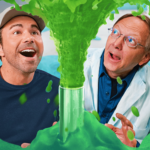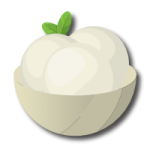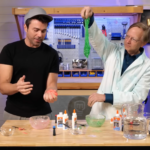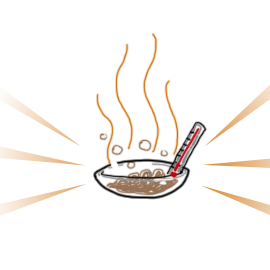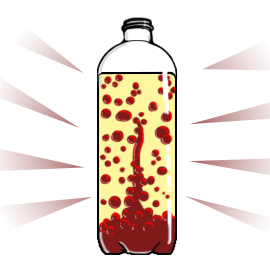YOU WILL NEED
Sometimes it’s hard to tell SCIENCE from MAGIC – and this little demonstration is a great example of that. In this experiment you will watch an almost clear liquid suddenly turn dark blue in a flash. It takes a bit of preparation, and probably a trip to the pharmacy for materials, but we think it’s worth it.
IMPORTANT SAFETY INFORMATION: This experiment should only be done with the help of an adult. Iodine will stain just about anything it touches and it can be hazardous. Hydrogen peroxide can cause eye and skin irritation – safety goggles are needed throughout the experiment. Be sure your helpful adult reads the caution labels on each container.
3 clear plastic cups 4 ounces or larger
A 1000 mg Vitamin C tablet from the pharmacy (you can also use two 500mg)
Tincture of iodine (2%) also from the pharmacy
Hydrogen peroxide (3%) yep, also from the pharmacy
Liquid laundry starch (see below for alternatives)
Safety goggles
Measuring spoons
Measuring cup
An adult helper
What to do
Put on those safety goggles and mash the 1000 mg Vitamin C tablet by placing it into a plastic bag and crushing it with a rolling pin or the back of a large spoon. Get it into as much of a fine powder as possible. Then put all the powder in the first cup and add 2 ounces (60 ml) of warm water. Stir for at least 30 seconds. (The water may be a little cloudy) Let’s call this “LIQUID A”
Now put 1 teaspoon (5 ml) of your LIQUID A into a new cup and add to it: 2 oz (60 ml) of warm water and 1 teaspoon (5 ml) of the iodine. Notice the brown iodine turned clear! Let’s call this “LIQUID B.” By the way, you’re done with LIQUID A – you can put it aside.
In the last cup, mix 2 oz of warm water, 1 Tablespoon (15 ml) of the hydrogen peroxide and 1/2 teaspoon (2.5 ml) of the liquid starch. This is, you guessed it, “LIQUID C”
Okay, that was a lot of preparation, on to the fun part. Gather the friends and family and pour all of LIQUID B into LIQUID C. Then pour them back and fourth between the 2 cups a few times. Place the cup down and observe….be patient….somewhere between a few seconds and a few minutes, the liquid will suddenly turn dark blue!
How does it work?
This is an example of the chemical reaction know as the IODINECLOCK REACTION. It is called a clock reaction because you can change the amount if time it takes for the liquids to turn blue. (see experiments below) The chemistry of the demonstration gets a bit complicated, but basically it is a battle of chemistry between the starch which is trying to turn the iodine blue, and the Vitamin C which is keeping it from turning blue. Eventually the Vitamin C loses and, bam! – you get instant blueness.
Note: If you do not have liquid starch, you can also use 1/2 teaspoon of corn starch or potato starch. The liquids will be more cloudy and the reaction will happen a bit more slowly, but it’s still impressive.
Clean up: Carefully pour all liquids down the drain with plenty of water and wash your hands. Recycle the cups or dispose of them in the trash.
MAKE IT AN EXPERIMENT
The project above is a DEMONSTRATION. To make it a true experiment, you can try to answer these questions:
1. Does the temperature of the water affect how quickly the liquids turn blue?
2. Does the amount of Vitamin C added (Liquid A) affect how fast the liquid turns blue?
3. Does stirring the liquids more affect how fast the liquids turn blue?
Science Bob




